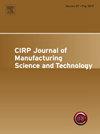聚合物微球油墨材料挤出3D打印:固体体积分数和挤出物膨胀对分辨率和合适工艺参数的影响
IF 5.4
2区 工程技术
Q2 ENGINEERING, MANUFACTURING
CIRP Journal of Manufacturing Science and Technology
Pub Date : 2025-05-09
DOI:10.1016/j.cirpj.2025.05.002
引用次数: 0
摘要
半固体油墨的3D打印在制药行业具有巨大的潜力。然而,制造工艺的成功依赖于足够的材料性能和优化的工艺参数。因此,更广泛地采用该技术需要对挤出过程之前,期间和之后出现的现象有深入的了解。本文阐述了挤压膨胀对3D打印过程的实际影响以及产生的物体质量。研究了在Carbopol凝胶基质中嵌入聚合物微球的可挤出墨水,并评估了挤出膨胀对打印质量的影响。忽略挤出膨胀会导致印刷细丝的伸长,从而导致薄壁物体的形状变形。然而,挤出率的修正可以由挤出物膨胀比确定,并通过实验验证。虽然挤出膨胀对打印分辨率有负面影响,但在打印后利用控制收缩也证明了一种抵消效果。本文章由计算机程序翻译,如有差异,请以英文原文为准。
Material extrusion 3D printing with polymer microsphere inks: Effects of solid volume fraction and extrudate swell on the resolution and suitable processing parameters
Material extrusion 3D printing of semi-solid inks holds tremendous potential in the pharmaceutical industry. However, the success of the manufacturing process relies on adequate material properties and optimized process parameters. Therefore, broader adoption of the technology requires a deep understanding of the phenomena present before, during, and after the extrusion process. This paper illustrates the practical effects of extrudate swell on the 3D printing process and the resulting object quality. Extrudable inks containing polymeric microspheres embedded in a Carbopol gel matrix were studied, and the effects of extrudate swell on print quality were assessed. Neglecting extrudate swell resulted in the extension of the printed filaments, leading to shape distortion in thin-walled objects. However, extrusion rate corrections could be determined from the extrudate swell ratios, which was experimentally validated. While extrudate swell negatively affected printing resolution, a counteracting effect was also demonstrated by utilizing controlled shrinkage after printing.
求助全文
通过发布文献求助,成功后即可免费获取论文全文。
去求助
来源期刊

CIRP Journal of Manufacturing Science and Technology
Engineering-Industrial and Manufacturing Engineering
CiteScore
9.10
自引率
6.20%
发文量
166
审稿时长
63 days
期刊介绍:
The CIRP Journal of Manufacturing Science and Technology (CIRP-JMST) publishes fundamental papers on manufacturing processes, production equipment and automation, product design, manufacturing systems and production organisations up to the level of the production networks, including all the related technical, human and economic factors. Preference is given to contributions describing research results whose feasibility has been demonstrated either in a laboratory or in the industrial praxis. Case studies and review papers on specific issues in manufacturing science and technology are equally encouraged.
 求助内容:
求助内容: 应助结果提醒方式:
应助结果提醒方式:


